Special Article
Stele Inscriptions and Historical Research
Ethnography Unit, Hong Kong Museum of History 2011
|
Stele inscriptions are a highly valuable resource for historical research. Perhaps the most renowned example is the Rosetta Stone: discovered in Egypt by the army of Napoleon in 1799, it was inscribed with an ancient text that, after it was studied and translated, gave experts the key to deciphering Egyptian hieroglyphics. China, too, possesses a wealth of stele inscriptions. While writing his
magnum opus
Shiji (
Records of the Grand Historian), Sima Qian (145 B.C.-90 B.C.) collected information on Qin dynasty (221 B.C.-206 B.C.) stone carvings in order to document historical events relating to the First Emperor (259 B.C.-210 B.C.) of the Qin dynasty. During the Northern Song dynasty (906-1127), the collection of and research into bronze ware and stele inscriptions emerged as a distinct field of study, known as
jinshixue, and several books were written on the subject. Reaching the height of its popularity in the Qing dynasty (1644-1911), the discipline still exerted an influence on the study of Chinese antiquities in the 1930s. However,
jinshixue focused primarily on ancient relics, and not all of the inscriptions on steles in temples and schools and on archways from later eras were recorded in the historical accounts of their particular locality. As the inscriptions faded with time, the historical information they contained was gradually lost.
To preserve the valuable historical information provided by inscriptions in Hong Kong, the Hong Kong Museum of History published its own record back in 1986. The three volumes of Historical Inscriptions of Hong Kong, the city's first compilation of this kind, contain 585 Chinese inscriptions collected by Dr David Faure, Dr Bernard Hung-kay Luk, Dr Alice Ngai-ha Ng Lun and their research assistants between 1978 and 1984. The majority of the inscriptions came before 1945 and were found in ancestral halls, temples and charitable institutions. The Folk Culture Gallery of The Hong Kong Story exhibition is currently showcasing a granite stele that was discovered in Causeway Bay during road works in the district in 1988. It was not included in Historical Inscriptions of Hong Kong but was later handed over to the Hong Kong Museum of History. The top part of the stele features a plaque carved in relief, on which the Chinese characters lian fu bei ("stele of collective benevolence") are inscribed in intaglio. The body of the stele has borders, and the names of 32 donors are listed in the centre, two of which are referred to as fushou (literally "first in benevolence"). The stele was erected to commemorate the act of benevolence by these donors that saw them contribute 235 dollars to the building of curbs and fences in front of a temple in the 12th year of the Guangxu reign (1887). The incised lines of the intaglio inscriptions bear no traces of paint, suggesting that colour was never been applied to the words. (See table below.) Reference to Historical Inscriptions of Hong Kong reveals that several of these donors are also recorded in a number of other temple stele inscriptions found on Hong Kong Island. For example, the names Tsang King Kee, Ng Shun Kee, Ngai Sang Lee, Tang Yuen Cheong, Yuen Sau Kee, Tsang Fat Kee and Dew Ng Kee appear on the "Stele Commemorating Sponsors of the Founding of Lo Pan Temple" in the 10th year of the Guangxu reign (1885), with Tsang King Kee also listed as one of the yuanshou (worshipper representatives) in the temple's founding. In addition, the inscriptions on the granite stele include the names of stone mines, including Liu Wo Lee Tong and Ko Man Shun Tong, suggesting a close connection to Hong Kong's early construction industry. Research by Professor Lo Hsiang-lin and Dr Siu Kwok-kin on Hong Kong's early masonry industry (1) has shown that Lee Yee Shing, Ngai Sam Lee and Dew Ng Kee were members of a dongjia hang (guild), while Tang Yuen Cheong, Tsang King Kee, Yuen Sau Kee, Chow Yee Wo, Yau Kung Cheong and Ngai Sang Lee were stone merchants from Hakka areas in Guangdong province who had business operations in Sheung Wan. This particular dongjia hang in the masonry industry had about 120 members, and its main responsibility was to organise celebrations for the Tin Hau festival in Causeway Bay. (2) Today, Hong Kong's masonry industry has almost disappeared, but this stele indicates that, during the city's early development, these stone merchants not only enjoyed great wealth but also played an active part in local affairs and made significant contributions to the building of temples. The "stele of collective benevolence" offers unique testimony to this period in Hong Kong's history. |
|
|
(1) Lo, Hsiang-lin, "Xianggang zaoqi zhi dashi shiji ji qi yu Xianggang jianshe zhi guanxi" (History of Hong Kong's early masonry industry and its relationship with construction and development) in Shike yuekan, vol. 1, issue 9 (15 December 1971), pp. 459-463. Siu Kwok-kin, "Xianggang kaibu chuqi dashi hangye" (Hong Kong's early masonry industry) in Siu Kwok-kin,ed., Xianggang lishi yu shehui (Hong Kong history and society), Hong Kong, Hong Kong Educational Publishing Co., 1994, pp. 59-71.
(2) Siu, op. cit., p. 61. 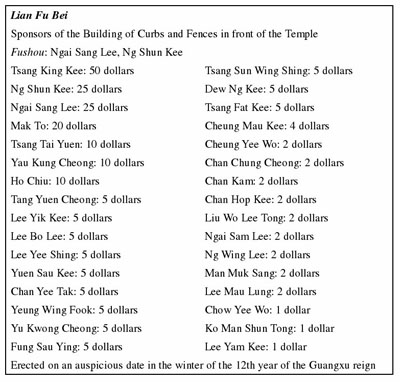
* Translation of the Chinese inscriptions
|
|

Historical Inscriptions of Hong Kong (in three volumes), published by the Hong Kong Museum of History in 1986.
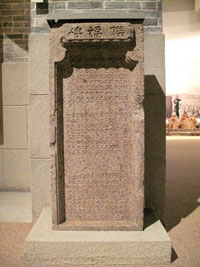
Lian fu bei ("stele of collective benevolence") on display at The Hong Kong Story exhibition.
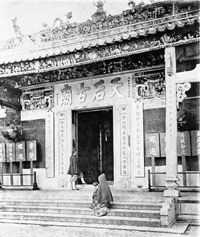
Tin Hau Temple in Causeway Bay
in the 1870s.
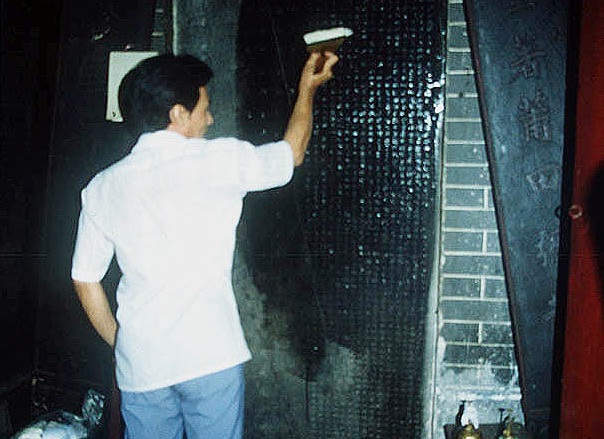
Making a rubbing of a historical stone tablet at Tin Hau Temple, Shap Pat Heung, Yuen Long, New Territories, 1982.
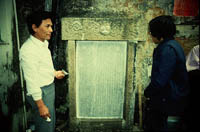
Making a rubbing of a historical stone tablet at Tin Hau Temple, Peng Chau, 18 January 1983.




